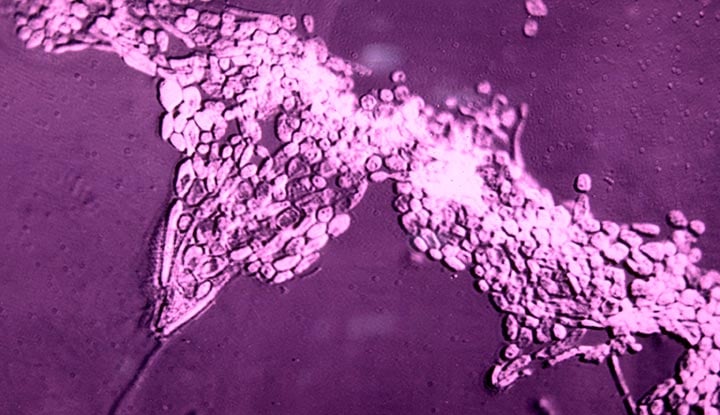Fighting Off Fungi: New Molecular Tool Joins the War Against Fungal Pathogen
By Eleonore Lebeuf-Taylor
3 May 2023

Candida albicans under the microscope (photo credit: Cleveland Clinic).
Scientists have just been handed a new tool to fight the rising threat of fungal infections.
Researchers in the Department of Molecular and Cellular Biology have developed a molecular system that can activate just about any gene in a common fungal pathogen, opening the door to both targeted genetic investigations and genome-wide screening. Their work was recently published in the journal G3: Genes Genomes Genetics.
“We optimized a CRISPR activation tool for use in Candida albicans and are now putting it out to the research community so that they can use it and play with it – it’s like a new toy,” says Nicholas Gervais, a PhD student in Dr. Rebecca Shapiro’s group and the study’s lead author.
C. albicans is a yeast species that lives on and in our bodies. Although often harmless, it can cause potentially fatal infections if the opportunity arises.
“In healthy adults, infections stay superficial, like vaginal yeast infections or oral thrush. But in vulnerable populations like elderly or immunocompromised people, Candida can enter the bloodstream and the mortality rate then jumps to 50%,” explains Gervais.
The high fatality rate is due to a lack of effective anti-fungal drugs as well as tools to study C. albicans. Unlike bacterial pathogens, which have received a great deal of scientific attention, fungal pathogens have been relatively neglected.
Enter CRISPR, a gene editing tool that allows researchers to manipulate an organism’s genetic code or, in the case of CRISPR activation, overexpress a gene of interest.
“CRISPR is a broad class of powerful genetic tools that were originally co-opted from bacterial and archaeal immune systems,” explains Gervais. “While most people are familiar with the traditional CRISPR-Cas9 system, which is used to induce breaks in DNA and manipulate sequences, CRISPR activation doesn’t edit DNA. Instead, it can be used to overexpress genes that you’re interested in studying.”
While CRISPR activation systems have been developed to study pathogenicity and drug resistance in bacteria, this is the first time that such a tool has been optimized for use in C. albicans.
“CRISPR activation existed in a related species, Saccharomyces cerevisiae or baker’s yeast, but it hadn’t been applied in Candida. There are certain things that you have to change and optimize for it to work at all in a different species, and then to work efficiently,” says Gervais.
The genetic tool can be used to overexpress any open reading frame – that is, any gene that will result in a protein. It is composed of two parts: a guide RNA, which acts like a roadmap to locate the gene of interest, and an activation complex, which induces overexpression.
When a custom-designed guide RNA binds to its complementary DNA sequence, the activation complex causes the target gene to be expressed many times above its normal levels. Thousands of genes can be thus activated by using unique guide RNAs tailored to particular sequences in the C. albicans genome.
The versatility of the CRISPR activation tool is what makes it so powerful.
“You can target anywhere in the genome,” says Gervais. “All you need to do is change the guide RNA – in other words, change the map that shows where the activation complex gets delivered.”
Behind the scenes, developing a CRISPR activation system for C. albicans came with its own set of challenges.
“There’s a lot that goes into successful guide RNA design and targeting the right area in the promoter,” explains Gervais. “A single nucleotide difference in the guide RNA can mean the difference between ten-fold overexpression and not working at all.”
The optimized activation tool will be especially helpful in the fight against antifungal resistance, as C. albicans often uses genetic overexpression as a means of resisting drugs. For example, the fungus can develop tolerance to a drug by overexpressing the genes responsible for pumping it out of its cell.
“Now that we have CRISPR activation, we can mimic those resistance mechanisms ourselves in order to study them,” says Gervais.
With many new collaborations already in the works, the novel CRISPR activation system is a powerful new tool scientists can now wield as we face the rising threat of pathogenic fungi.
This study was funded by NSERC, MITACS, and Ontario research awards.
Read the full study in the journal G3.
Read about other CBS Research Highlights.